Blog by Tina McIntyre and Morgan Pinkerton, UF/IFAS Extension Seminole County
What are some commonly encountered invasive weeds in urban areas and what should I know about them?
Land managers use pesticides to eradicate established invasives, so avoiding these species not only maintains our precious Floridian food web, but reduces the amount of chemicals that are used in our natural areas. Mowing, tillage or weed-eating many of these species will not remove the plants entirely. Instead, plants can be dug up with a shovel, with the aim to remove the entire root mass. By making responsible choices and not planting invasive species, you’ll help safeguard Florida’s natural areas for future generations to enjoy. Below you will find some invasive plants commonly found in urban areas. Click the plant names to find out more information on each species.
Asparagus fern, Asparagus aethiopicus
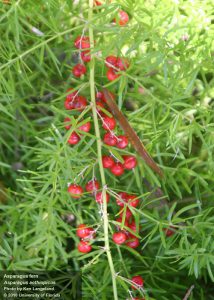
This plant not a true fern. It is native to S. Africa, but was planted here in yards and gardens. It is important to remove this plant form your landscape because the berries that contain the seeds are dispersed by birds. Instead of planting Asparagus Fern, we recommend our native Coontie (Zamia pumila) or Dwarf Walter’s viburnum (Viburnum obovatum ‘nana’).
Balsam Apple, Momordica balsamina
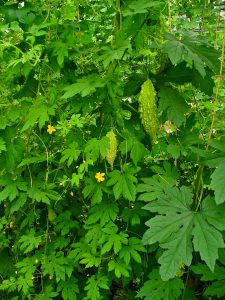
This invasive Category II vine is prevalent in over 30 Florida counties. It is native to Africa. The fruits and leaves are used medicinally, but the seeds are toxic. It was likely brought to our state for that reason and escaped the cultivated area. It is in the squash family. Like the squash plants grown for food, Balsam apple also has small yellow flowers and broad leaves.
Camphor Tree, Cinnamomum camphora
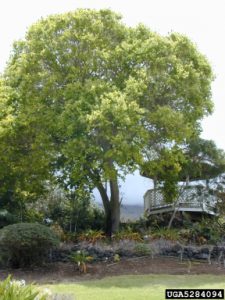
Camphor tree was planted and widely used Central Florida in the 1950’s. Unfortunately, it is now a common invasive plant. The black berries are dispersed by birds and other animals. Camphor leaves smell and are the source for camphor essential oil. If you crush the leaves you will find a characteristic smell that helps identify the species. These trees become large shade trees, so care should be taken to remove small seedlings from landscape beds prior to establishment.
Chinaberry, Melia azedarach
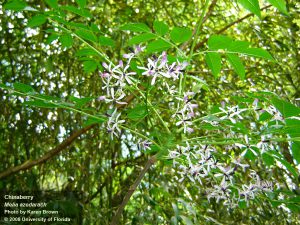
Originally introduced through the ornamental plant industry, this plant escapes urban areas and moves to natural areas where it invades roadsides and displaces native trees. Studies have shown a cut stump treatment of 8% triclopyr is almost completely effective in eliminating Chinaberry. Herbicides should be applied before the onset of fruit production to prevent seed production. Repeat applications may also be necessary for complete control.
Chinese Tallow, Triadica sebifera (Sapium sebiferum)
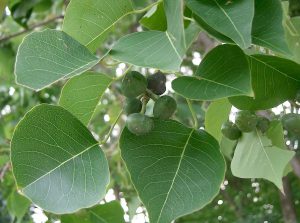
This large tree can be seen in wet or dry areas. It has unique tear-drop shaped leaves. Seasonally, the leaves will turn a reddish color and the seeds form after tiny white flowers. The leaves and fruit are toxic to cattle and can cause nausea and vomiting in humans. Homeowners can help mitigate the problem of Chinese tallow trees in Florida’s natural areas by removing them from their property.
Golden rain tree, Koelreuteria paniculata
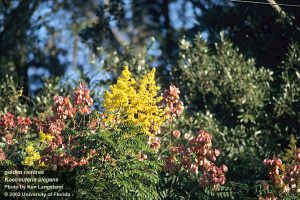
Yet another plant that was sold at nurseries for its beautiful yellow flowers and pinkish bracts (looks like a flower petal), this plant produces thousands of seeds that germinate readily in urban and rural areas. These are medium to large trees with many small leaves on one stem, giving it a whimsical feel. Koelreuteria has the ability to crowd out desired native species, so we do recommend (like Camphor and Chinaberry trees) removing established plants.
Mexican Petunia, Ruellia simplex
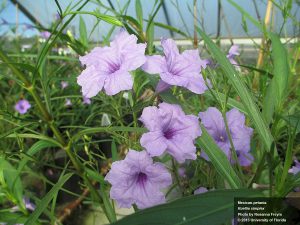
This plant was also available commercially and is now a headache for land managers. You shouldn’t plant Mexican petunia in your garden. Some cultivars like ‘Purple Showers’ have been tested and specifically found not to be invasive by re-seeding. However, even this cultivar is aggressive in vegetative rhizome growth. There’s also a native wild petunia, Ruellia caroliniensis, that we recommend for full sun areas instead of the invasive species.
Skunk Vine, Paederia foetida
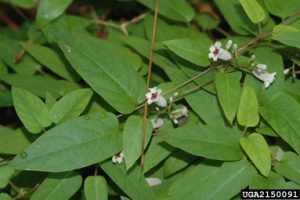
This quick growing vine forms root tubers in the ground and smothers native trees. It stinks like cat urine and skunk, so the smell gives it away. The tubular white and purple flowers can be seen in the late summer or early fall. When removing this plant, be sure to dig up the roots as well as removing the vines.
Tuberous or Boston Sword Fern, Nephrolepis cordifolia
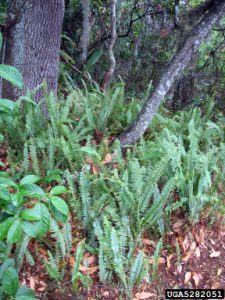
This fern is another that was embraced by the horticulture industry and is still available as an INDOOR plant. These plants should never be planted outside. Existing plants can be identified by their characteristic spherical tubers under the soil. When removing, be sure to remove the tubers as well, otherwise they will be back to visit the next season. This should not be confused with Nephrolepis exaltata, our native Sword Fern.
Wedelia, Sphagneticola trilobata
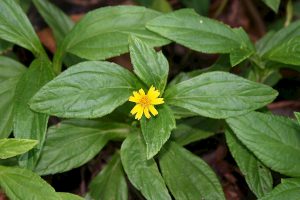
This herbaceous groundcover was embraced by the horticulture industry. Now a persistent pest, this plant is challenging to eradicate. Mowing or slashing of wedelia infested areas should be avoided. This may cause the development of new plants. Uproot the weed from the areas where it grows, followed by an application of glyphosate on the infested area.
Interested in participating in Weed Wrangle© Week 2021?
Check out this article for more information on what is going on locally this week. Be sure to catch all the other cool resources we are sharing this week on our Central Florida CISMA Facebook page!
More Resources
- Central Florida Cooperative Invasive Species Management Area
- Florida Invasive Species Partnership
- Florida First Detector Program
- Invasive Weeds EDIS Documents
- UF Center for Aquatic and Invasive Plants
- WeedWrangle.org
 0
0
